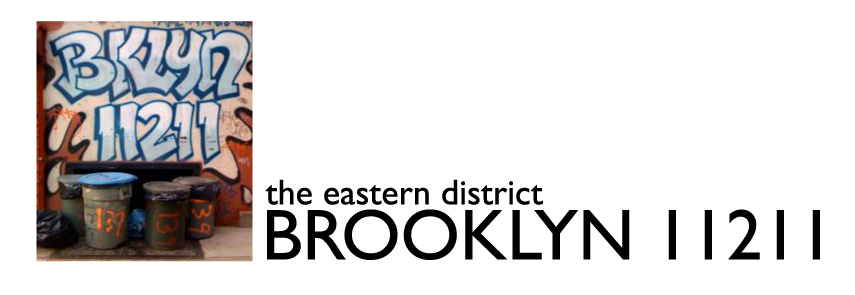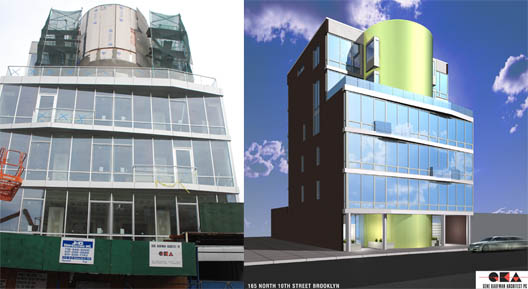Genius advertisement for the Dems for Mitt movement (The Mitten for the Mitt?):
More Democrats for Romney
Democrats for Romney
Michigan Democrats should vote for Mitt Romney, because if Mitt wins, Democrats win.
Any Affordable at Berry and North 12th?
From Brownstoner, word today that the parking lot at the corner of Berry and North 12th (last used by Brooklyn Brewery to park their trucks) is going to be a rental project:
Last month Manhattan-based real estate firm LCOR partnered with Lehman Brothers and the California State Teachers’ Retirement System to buy 34 Berry Street, and they plan to build a 6-story, 140-unit rental on the site.
The site is very large, and zoned for R6A – the big question is will it use the inclusionary housing program to provide affordable housing?
The inclusionary housing bonus on upland sites has so far been a disappointment. Only one project (at Kent and North 8th) has opted to build with the bonus. Dunn Development’s Cook and Varick Street project hopes to have some of its affordable housing generate bonuses for upland sites further west (it is also the receiving site for some of the waterfront affordable housing). But clearly, developers have not been rushing out to build affordable housing upland.
There are a few reasons for this, all of which might be solvable at 34 Berry. First off, most development in the Northside and Greenpoint (the only areas where the inclusionary bonus applies) has been condominium, and it is difficult to structure onsite affordable in a condominium project (unless you put the affordable housing offsite, which was done at Kent and North 8th). Second, you need a project with a certain minimum density – R6B clearly doesn’t have much potential to generate affordable housing, but a large R6A site such as this might.
So perhaps the stars might finally align for a project to build affordable housing under the existing zoning guidelines (rather than throwing out the zoning entirely).
Speaking of Branding
Further to the discussion yesterday about the idiocy of naming your new condominium development after a light switch, it is worth pointing out that the (shudder) Decora was designed by the same architect that brought us the Lucent. I have no idea if the same marketing geniuses are behind both projects, but it wouldn’t surprise me if the same folks who would name their new condominium development after a recently bankrupt casualty of the dot-com boom would also name a development after a line of lighting fixtures available at the local Home Depot.

But lest you think stupid branding decisions are limited to only to ugly Brooklyn condominium projects, they are not. Take, for instance, Xerox – the venerable office technology company. Clearly, their pixellated “X” logo was not cutting it, so they turned to Interbrand, who came up with a cutting-edge X-on-a-ball logo. Surely they have a good reason for this change:
Our new brand reflects who we are [the Danish national football team?], the markets we serve and the innovation that differentiates us in our industry. We have expanded into new markets, created new businesses, acquired new capabilities, developed technologies that launched new industries — all to ensure we make it easier, faster, and less costly for our customers to share information
Congratulations, now no one has the faintest idea what the hell you sell.
If that meaningless marketing babble sounds familiar, chances are you’ve been going to open houses in the neighborhood:
Warehouse 11 [warning – highly annoying techno loop] debuts 120 designer living environments—studios, one- and two-bedrooms—dreamt up by the noted Andres Escobar & Associates. All created with a whimsically artistic, outside-the-lines approach. Crisscrossing Chic Industrial and Sumptuous Modern in Williamsburg’s oh-so-sweet Bedford Avenue/McCarren Park location.
Clearly, our nation’s marketers have run out of words. And ideas.
Too Easy
This is too damn easy:
We’ve been watching this scary unique building 165 N. 10 Street in the Burg unfold ever since we laid eyes on the rendering […] from the drawing boards of Gene Kaufman Architect… In the meantime, the building is now being identified as The Decora… [Curbed]
Kaufman’s Decora:
Leviton’s Decora light fixture:
Dedication to a Cause
Listening to New & Notes on NPR just now, a caller phoned in to discuss the state of the Democratic primary (Hillary & Barack). The caller noted that he was a life-long independent, but had switched his party affiliation this year. He joined the Republican party just so he could vote against Rudy Giuliani in the primary.
Nice.
Ferries close, ferries open
NYT has a another update on the ferry closure (and the new operators for the Statue of Liberty/Ellis Island ferries). According to Tom Fox, owner of NY Water Taxi, Schaefer Landing’s developer has been paying to subsidize service, but even that is not enough to cover costs. (No word here on whether or not any developers in LIC are also subsidizing the water taxi.) Also, news that the City does have funds available that might be used for an operational subsidy.
The article includes a photo of deckhands Damien and Ali from the afternoon shift. Last I heard, they were still unemployed as of New Year’s Day.
What if Iowa Doesn’t Decide?
Whoa – states other than Iowa may have a say in who the next President will be? What’s this country coming to?
RIAA: We Are All Crooks Now
This Washington Post article has been getting a lot of play, and from a pretty diverse group of bloggers (like here, here, and here – not to mention every tech blog on the planet). (It also looks as though the suit in question is not over copying CDs, but rather downloading. Regardless, RIAA goes on record saying that copying CDs is illegal.)
None of this should be a surprise – the original drafts of the Digital Millennium Copyright Act tried to make it illegal to copy any digital content. Whether that made it into the final Act, I don’t know, but that was certainly the position of the content-provision industry all along.
And why not? This is an industry whose entire business model for the past quarter century has been based on selling you stuff you already own. In the 80s, they sold you CDs to replace the records you already bought. Every Christmas since, they repackage greatest hits compilations to sell you more stuff that you probably already own. Now they want us to pay to download music that we probably already own in two or three different formats and on two or three different albums. With a business model like that, suing your customers makes a hell of a lot more sense than trying to come up with a quality product worth buying.
Water Taxi Connections
In the comments section of my last post, Cap’n Transit points to an entry on his blog that brings up an aspect of making connections to the ferry that I had not considered. Namely, that the ferry companies do it. The Cap’n mentions the success that New York Waterway (the “Jersey ferry”) has had with running shuttle buses both in Manhattan and New Jersey. Imperatore and company figured out long ago that without connections on the land side, ferries were really only useful to people who lived and worked within a short walk of the ferry. By providing an extensive shuttle service on land, NYWW has greatly expanded its customer base. By doing so, they effectively eliminate the need to get on public transit in Manhattan, thus eliminating the two fare problem (in the process, though, adding to the congestion on Manhattan streets).1
I’d recommend reading Cap’n Transit’s original blog post (Water Taxi: What If?). He also touches on the issue of accessibility that I discussed, but from the point of view of LIC commuters. The formula remains the same (live near the ferry, work near the ferry – no problem), he just provides more and different examples. The rest of the blog is also worth a tour.



